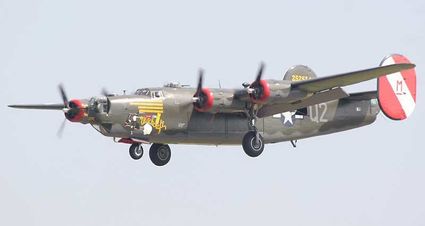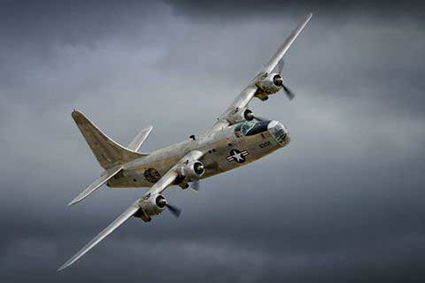Consolidated Globemaster II – Ruben Fleet's Rugged Bomber
Short Flights

This photo, taken by Brian Lockett of Goleta, shows a B-24J Liberator landing at Camarillo Airport and carrying the name of Witchcraft on the nose.
Reuben H. Fleet founded Consolidated Aircraft Corporation (later Convair) in 1923, and the company became one of the most significant aircraft manufacturers in American history. For roughly 60 years, this prolific company was synonymous with San Diego. This company was responsible for building some of the most significant aircraft in aviation history, including the PBY Catalina, B-24 Liberator, F-102 Delta Dagger, as well as the reliable Atlas missile, which was vital in launching America into space. Fleet's popular slogan, "Nothing short of right is right" was painted across the front of the manufacturing building in San Diego in huge letters.
Some years back, I found this quote that I liked immediately when I saw it by John Katzenbach, author of Hart's War (POW story in WWII) – I feel it fits with my enthusiasm for history and even with events happening today: "Sometimes I think we live in a world so obsessively devoted to looking forward that it frequently forgets to take the time to look back. But some of our best stories reside in our wake, and I suspect, no matter how harsh these stories are, they help tell us much about where we are heading."
Most of my friends know that I love old books, history books, especially airplane history books. True, there is every kind of information imaginable on the Internet, but there is something special to me about running my hands over the paper pages of a book. The feel, the smell, the style of writing, are all important to me.
Back in 2005, our late friend, Vern LaBeaux of the Mojave Lion's Club, gave us a wonderful collection of books that had belonged to his father about the Consolidated B-24D Liberator, World War II bomber. There are six hardbound technical manuals still in the original leather case. We do treasure these books and appreciate Vern entrusting them to us.
Over 18,000 B-24's were produced, but sadly only one is airworthy today. First flight of the XB-24 was in Dec. 1939 and they entered service in 1940. The B-24's tricycle landing gear was the first installed in a heavy bomber aircraft. Another difference was the twin tail fins and oval shaped engine cowlings due to the mounting of turbo-superchargers. It had a mid-mounted, high-lift Davis wing that achieved 20 percent less drag than conventional airfoils of the time. David R. Davis was a free-lance aeronautical engineer who was looking for development funds for his wing design, the "Fluid Foil." Ruben Fleet and Consolidated's Chief Engineer, Isaac M. Laddon were finally impressed with the design after wind tunnel testing was accomplished at CalTech. The same Davis wing was used on the B-32 Dominator too.
The unique roll-up bomb bay doors reduced drag when open, and a fully retractable ventral machine gun turret was installed. The B-24 was the first aircraft to employ Hamilton hydromatic, quick-feathering, three-blade propellers.
Four 1,200-hp Pratt & Whitney R-1830-65 Twin Wasp turbocharged radial piston engines powered the B-24 and the maximum speed at 25,000 feet was 303 mph. Equipped with eleven .50-caliber machine guns, and a maximum bomb load of 8,000 pounds, more B-24's were built than any other American airplane.
There were five different plants building B-24's. The San Diego Consolidated plant was the prime manufacturer, supplying components to Fort Worth and Douglas in Tulsa for assembly.
Ford's Willow Run plant broke ground in April 1941. Dormitories were built on the site and a commuter rail line was extended to it. The automobile assembly-line style of manufacturing had to be adapted to aircraft production. In 1943, with 42,000 employees, The Ford plant was producing 230 B-24s per month. By the end of 1944, they produced 650 per month! When production ended in April 1945, Willow Run had turned out over 8,600 Liberators.

Our aviation photographer friend, Matt Ottoson, captured this beautiful PB4Y flying at the Chino Air Show this year!
While designed as a heavy bomber, the B-24 experienced more than 100 modifications and conversions for such assignments as photography, mine laying, cargo hauling and a C-109 fuel tanker version that flew "the Hump" to refuel B-29s operating out of forward bases in China. More than 18,000 B-24s were built during WWII, more than any other American aircraft. Given its abilities and "convert-abilities," the numbers make perfect sense. However, a postwar attempt to combine portions of the B-24 and PB4Y-2 with a new fuselage to create the Convair Model 39 airliner was not a commercial success, with only one prototype being built.
During World War II, motion picture actor and Tehachapi resident, Jack Palance, was a B-24 bomber pilot. He crashed and received severe burns that led to extensive facial surgery, resulting in an individual look that created many roles in movies.
Another Hollywood star who flew B-24's was Jimmy Stewart and he went on to become a Brigadier General in the U.S. Air Force!
Happy 70th Birthday to the U.S. Air Force, formed on September 18, 1947!
See you on our next flight!




